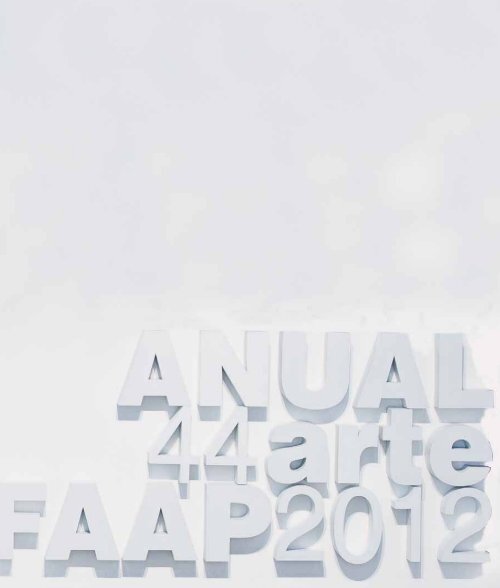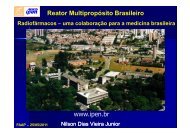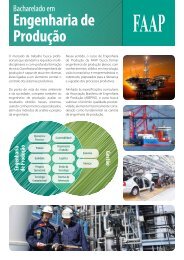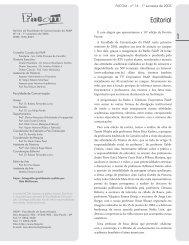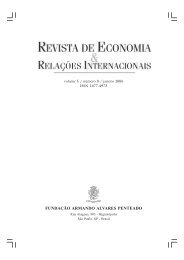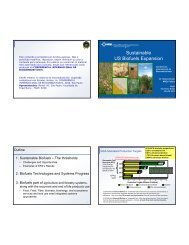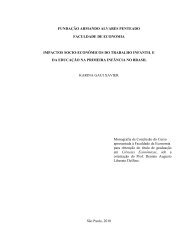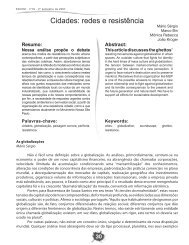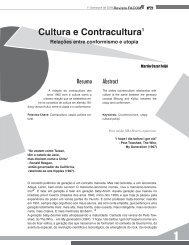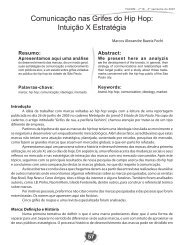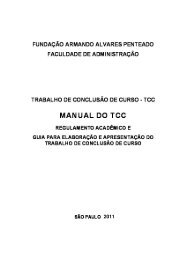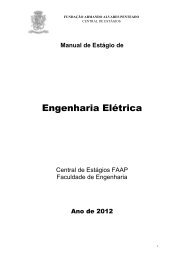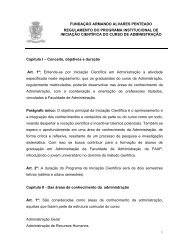You also want an ePaper? Increase the reach of your titles
YUMPU automatically turns print PDFs into web optimized ePapers that Google loves.
2<br />
FUNDAÇÃO ARMANDO ALVARES PENTEADO<br />
CONSELHO CURADOR<br />
Presi<strong>de</strong>nte<br />
Sra. Celita Procopio <strong>de</strong> Araujo Carvalho<br />
Membros do Conselho<br />
Dr. Benjamin Augusto Baracchini Bueno<br />
Dr. Octávio Plínio Botelho do Amaral<br />
Dr. José Antonio <strong>de</strong> Seixas Pereira Neto<br />
Sra. Maria Christina Farah Nassif Fioravanti<br />
Embaixador Paulo Tarso Flecha <strong>de</strong> Lima<br />
DIRETORIA EXECUTIVA<br />
Diretor Presi<strong>de</strong>nte<br />
Dr. Antonio Bias Bueno Guillon<br />
Diretor Tesoureiro<br />
Dr. Américo Fialdini Jr.<br />
Diretor Cultural<br />
Prof. Victor Mirshawka<br />
ASSESSORES DA DIRETORIA<br />
Área Administrativa e Financeira<br />
Dr. Sérgio Roberto <strong>de</strong> F. S. e Marchese<br />
Área Acadêmica<br />
Prof. Rogério Massaro Suriani
FACULDADE DE ARTES PLÁSTICAS<br />
Diretor<br />
Prof. Silvio Passarelli<br />
Coor<strong>de</strong>nação<br />
Prof. Marcos José S. <strong>de</strong> Moraes<br />
Coor<strong>de</strong>nador do Curso <strong>de</strong> Educação Artística – Artes Plásticas<br />
Prof. Milton Francisco Junior<br />
Coor<strong>de</strong>nador do Curso <strong>de</strong> Desenho Industrial<br />
Prof. José Renato Bicalho Kehl<br />
Coor<strong>de</strong>nador do Curso <strong>de</strong> Arquitetura e Urbanismo<br />
Prof. Ivan Marcos Caminada Bismara<br />
Coor<strong>de</strong>nador do Curso <strong>de</strong> Moda<br />
Prof. Vitor José B. Campos<br />
Coor<strong>de</strong>nador das Oficinas<br />
Prof. Carlos Eduardo Leite Perrone<br />
Coor<strong>de</strong>nador <strong>de</strong> Pós-Graduação e Extensão<br />
Secretário da Faculda<strong>de</strong><br />
Edio Alvarenga <strong>de</strong> Souza Junior<br />
Assistentes <strong>de</strong> Diretoria<br />
Silvia Cristina Castilho <strong>de</strong> Arantes<br />
Andréia da Silva dos Anjos Paes<br />
Apoio Coor<strong>de</strong>nação<br />
Cinthya Félix <strong>de</strong> Vasconcelos<br />
Alessandra Rodrigues Monteiro
SUMÁRIO<br />
6 | 31<br />
EXPOSIÇÃO<br />
32 | 36<br />
A 44ª EDIÇÃO ANUAL DE ARTE DA <strong>FAAP</strong><br />
37 | 93<br />
ARTISTAS SELECIONADOS<br />
94<br />
ALUNOS SELECIONADOS / NOME ARTÍSTICO<br />
96 | 97<br />
ARTISTAS CONVIDADOS<br />
HENRIQUE CÉSAR e THIAGO HONÓRIO<br />
98 | 99<br />
PROGRAMAÇÃO DE ATIVIDADES PARALELAS<br />
100 | 101<br />
VERSÃO PARA O INGLÊS / TRANSLATION INTO ENGLISH<br />
4
32<br />
A 44ª edição Anual <strong>de</strong> Arte da <strong>FAAP</strong><br />
Iniciada em 1964 e organizada <strong>anual</strong>mente pela Fundação Armando Alvares Penteado, para<br />
apresentar a produção visual dos integrantes <strong>de</strong> seus cursos, a mostra po<strong>de</strong> ser percebida como<br />
uma das mais tradicionais e duradouras, <strong>de</strong>ntre as <strong>de</strong> <strong>arte</strong> contemporânea, realizadas na cida<strong>de</strong> <strong>de</strong><br />
São Paulo.<br />
Por seu tempo <strong>de</strong> existência e longevida<strong>de</strong> <strong>de</strong> presença no circuito artístico da cida<strong>de</strong>, a história da<br />
exposição já é conhecida, mas é sempre oportuno relembrar que a Anual <strong>de</strong> Arte da <strong>FAAP</strong> tem sua<br />
origem associada ao curso <strong>de</strong> formação <strong>de</strong> professores <strong>de</strong> <strong>de</strong>senho, um dos pioneiros nesta<br />
condição, em São Paulo, ainda na década <strong>de</strong> 1950. O início da exposição está, também, muito<br />
próximo da inauguração do Museu <strong>de</strong> Arte Brasileira da <strong>FAAP</strong> e, ainda, da própria criação da<br />
Faculda<strong>de</strong> <strong>de</strong> Artes Plásticas em 1967. No <strong>de</strong>correr das décadas seguintes, em particular no início<br />
dos anos 1990, ela se <strong>de</strong>senvolveu, ampliando-se para receber a produção dos alunos originários<br />
dos cursos que passaram a integrar a Faculda<strong>de</strong>, ao longo daquele período. Até meados daquela<br />
década a Anual consistia – ainda sem processos seletivos <strong>de</strong>finidos e explícitos – na apresentação<br />
do conjunto <strong>de</strong> trabalhos que resultaram da participação do corpo discente <strong>de</strong> todos os cursos da<br />
Faculda<strong>de</strong>.<br />
A partir da edição <strong>de</strong> 1999 novas diretrizes foram sendo implementadas e a exposição foi tomando<br />
a feição e o perfil que ela hoje apresenta: uma proposta <strong>de</strong> direcionar-se especificamente para a<br />
seleção, apresentação e articulação <strong>de</strong> um conjunto <strong>de</strong> manifestações na área <strong>de</strong> <strong>arte</strong>s visuais;<br />
apontando o que po<strong>de</strong> ser visto como potencial, e como possibilida<strong>de</strong>s <strong>de</strong>sta produção visual.<br />
Outra característica fundamental e inerente ao projeto da Anual é sua forma ampla <strong>de</strong> participação,<br />
traduzida pelo processo <strong>de</strong> inscrição e seleção oferecido, <strong>de</strong> forma aberta a toda a comunida<strong>de</strong> da<br />
Instituição, o que afirma, uma vez mais, seu projeto <strong>de</strong> fomento e suporte às ativida<strong>de</strong>s <strong>de</strong> natureza<br />
criativa, artísticas e culturais. A seleção das obras inscritas, e temos aqui outra peculiarida<strong>de</strong> do<br />
processo, que se faz pela apreciação dos trabalhos - e não como é habitual, em processos <strong>de</strong>sta<br />
natureza, por intermédio <strong>de</strong> registros e documentos (fotografias ou portfólios) - possibilita a<br />
concepção e organização da exposição que, <strong>de</strong>sta forma proporciona uma leitura das investigações<br />
<strong>de</strong>senvolvidas, pelos alunos, a partir <strong>de</strong> ações iniciadas no âmbito acadêmico.<br />
Em sua quadragésima quarta edição, a Anual <strong>de</strong> Arte, mais uma vez po<strong>de</strong> ser apresentada como<br />
uma ativida<strong>de</strong> que privilegia a inovação e o potencial criador, integrando o projeto institucional da<br />
Fundação que, <strong>de</strong> forma coerente com seus objetivos e i<strong>de</strong>ais, atua incentivando e apoiando a<br />
produção artística e cultural, mas também, e principalmente, no sentido da valorização das ativida<strong>de</strong>s<br />
da Faculda<strong>de</strong> <strong>de</strong> Artes Plásticas ao oferecer condições e suporte para a visibilida<strong>de</strong> externa, da<br />
produção contemporânea, objeto <strong>de</strong> investigação e formação profissional, fundamental no âmbito<br />
da Faculda<strong>de</strong>. O apoio implica, assim, na reafirmação da relevância do trabalho <strong>de</strong> seu quadro
docente e discente, e na crença do papel e do potencial da <strong>arte</strong> como agente vital no processo <strong>de</strong><br />
reflexão e transformação, no mundo contemporâneo.<br />
É relevante ter-se em mente a idéia que uma escola <strong>de</strong> <strong>arte</strong> <strong>de</strong>va ser um espaço <strong>de</strong> ensino <strong>de</strong> <strong>arte</strong>,<br />
mas fundamentalmente <strong>de</strong> criação, <strong>de</strong> investigação, <strong>de</strong> experiência, <strong>de</strong> reflexão, <strong>de</strong> extroversão, <strong>de</strong><br />
articulação <strong>de</strong> diferentes instâncias do sistema artístico, o que faz <strong>de</strong>la um espaço privilegiado e<br />
permite que ela seja, potencialmente, um dos instrumentos mais eficazes para produzir discussões<br />
e transformações fundamentais necessárias ao <strong>de</strong>senvolvimento artístico. Neste sentido, a mostra<br />
se propõe a colaborar no processo <strong>de</strong>stas discussões.<br />
A 44ª Anual <strong>de</strong> Arte da <strong>FAAP</strong> apresenta um conjunto <strong>de</strong> trinta e sete obras produzidas por vinte e<br />
nove alunos que possibilitam um olhar panorâmico sobre a experiência das práticas artísticas<br />
contemporâneas <strong>de</strong>senvolvidas pelo corpo discente da Fundação, particularmente aquela vinculada<br />
às pesquisas <strong>de</strong> natureza visual.<br />
A exposição reúne as propostas <strong>de</strong>stacadas pela Comissão <strong>de</strong> Seleção composta por integrantes<br />
do corpo docente do curso <strong>de</strong> Artes Visuais que, ao selecionarem os alunos e seus trabalhos,<br />
articularam uma possível compreensão, do conjunto da produção apresentada para este processo.<br />
Se a pesquisa, bem como o caráter experimental, são elementos fundamentais no que costumamos<br />
i<strong>de</strong>ntificar como produção artística, na seleção aqui apresentada, estes foram dois dos principais<br />
critérios utilizados, possibilitando assim que, a mostra permaneça fiel ao seu espírito <strong>de</strong> dar<br />
visibilida<strong>de</strong> às propostas <strong>de</strong> inovação, mas também na busca por refletir a presença da diversida<strong>de</strong><br />
<strong>de</strong> proposições, questões e tratamentos, i<strong>de</strong>ntificáveis nas práticas artísticas contemporâneas, e<br />
das reflexões, <strong>de</strong>las <strong>de</strong>correntes.<br />
Como programação paralela, e ativida<strong>de</strong> complementar da exposição, ainda no intuito <strong>de</strong> afirmar<br />
seu caráter <strong>de</strong> espaço <strong>de</strong> discussão, a Anual realiza ações paralelas que, nesta edição se<br />
concretizam com a realização <strong>de</strong> encontros com o objetivo <strong>de</strong> potencializar os momentos <strong>de</strong><br />
trocas reflexivas sobre estas experimentações e práticas artísticas contemporâneas perceptíveis<br />
no processo <strong>de</strong> formação dos alunos, e visíveis, na exposição.<br />
O Encontro com a Comissão <strong>de</strong> Premiação1 , logo no início da exposição, possibilitou <strong>de</strong>s<strong>de</strong> uma<br />
abordagem sobre o caráter – inevitável - <strong>de</strong> uma parcela <strong>de</strong> subjetivida<strong>de</strong> sempre presente em<br />
situações, <strong>de</strong>sta natureza; ou ainda na afirmação, para os alunos presentes, da distinção entre uma<br />
mostra assemelhada ao formato ‘salão’, e uma exposição com recorte curatorial, na qual é<br />
fundamental o papel da pesquisa e as possibilida<strong>de</strong>s <strong>de</strong> i<strong>de</strong>ntificação, por exemplo, <strong>de</strong> percursos<br />
dos artistas envolvidos. De outro lado, ainda, foi possível abordar pontos, ou refletir sobre questões<br />
1 Com a participação <strong>de</strong> Felipe Scovino, Roberto<br />
Tejada, Tobi Maier e a mediação <strong>de</strong> Marcos<br />
Moraes, foi realizado em 13 <strong>de</strong> novembro <strong>de</strong><br />
<strong>2012</strong>, no Salão Cultural/MAB <strong>FAAP</strong>.
34<br />
2 No dia 23 <strong>de</strong> novembro <strong>de</strong> <strong>2012</strong>, no Salão<br />
Cultural/ MAB <strong>FAAP</strong>, com a participação<br />
<strong>de</strong> Andrea Tavares, Gustavo Rezen<strong>de</strong>,<br />
Marcos Moraes e Nancy Betts.<br />
frequentemente presentes na produção artística atual, mas também sobre aqueles que os integrantes<br />
da Comissão se ressentiram em não perceber presentes, nesta edição da Anual. Neste sentido a<br />
ausência <strong>de</strong> pesquisas relacionadas ao uso <strong>de</strong> arquivos, <strong>de</strong> textos, ou mesmo a não seleção <strong>de</strong><br />
performances, ou trabalhos produzidos coletivamente, ou em colaboração, foram apontados não<br />
apenas como inexistentes, mas como relevantes pontos a serem pensados pelos alunos.<br />
Em seu objetivo <strong>de</strong>, não apenas participar <strong>de</strong>fen<strong>de</strong>ndo pontos <strong>de</strong> vista, ou ‘olhares estrangeiros’,<br />
<strong>de</strong> participantes do processo <strong>de</strong> selecionar os premiados, mas vivamente interessados em ouvir, e<br />
na possibilida<strong>de</strong> da troca que a ocasião oferecia, propuseram aos presentes que falassem sobre<br />
seus trabalhos, selecionados, ou não. Neste ponto as possibilida<strong>de</strong>s, mais uma vez se abriram para<br />
que fossem ouvidas <strong>de</strong>s<strong>de</strong> as tradicionais – e nem simples <strong>de</strong> serem respondidas – perguntas<br />
sobre os critérios <strong>de</strong> premiação, ou sobre as opções por linguagens, materiais e suportes e sua<br />
aceitação, ou não; ou ainda sobre os mo<strong>de</strong>los a serem seguidos para ser aceito, ou para ser<br />
inserido no “mercado <strong>de</strong> <strong>arte</strong>”.<br />
A maior p<strong>arte</strong> das indagações serviu, em verda<strong>de</strong>, para momentos <strong>de</strong> reflexão e discussão sobre<br />
valores e conceitos como os <strong>de</strong> i<strong>de</strong>ntida<strong>de</strong>, colaboração, coletivo, natureza, cida<strong>de</strong>, urbanismo,<br />
ética, ensino <strong>de</strong> <strong>arte</strong>, crítica institucional, a profissionalização, subjetivida<strong>de</strong>, a irrealida<strong>de</strong> <strong>de</strong> objetivos,<br />
o tempo <strong>de</strong> aprendizado e <strong>de</strong> amadurecimento; ou ainda sobre as características atuais e a<br />
consequente necessida<strong>de</strong> <strong>de</strong> o artista colocar-se em re<strong>de</strong> e articular-se com profissionais da área.<br />
Elas ainda serviram <strong>de</strong> ponto <strong>de</strong> partida para que os três membros da Comissão comentassem<br />
sobre a surpresa <strong>de</strong> uma exposição nestes termos e mo<strong>de</strong>lo, realizada em uma escola <strong>de</strong> <strong>arte</strong>,<br />
assim como as aproximações com o que acontece em outras escolas <strong>de</strong> <strong>arte</strong> pelo mundo, portanto<br />
nas relações com a aceleração dos processos <strong>de</strong> comunicação e a internet, ao referirem-se, cada<br />
um <strong>de</strong>les, aos seus universos <strong>de</strong> atuação, em cida<strong>de</strong>s como Frankfurt, Londres, Nova York Cida<strong>de</strong><br />
do México, Houston, ou Rio <strong>de</strong> Janeiro.<br />
Em um segundo momento foi realizado o Encontro com a Comissão <strong>de</strong> Seleção2 , que se iniciou com<br />
uma fala/ <strong>de</strong>poimento dos integrantes, sobre a experiência <strong>de</strong> estar no processo <strong>de</strong> seleção; assim<br />
como a diferença <strong>de</strong> trabalho e <strong>de</strong> abordagem, daquela realizada pela Comissão <strong>de</strong> Premiação. O<br />
trabalho <strong>de</strong> análise, mais <strong>de</strong>morado, tanto em função da quantida<strong>de</strong> dos trabalhos inscritos, quanto<br />
da necessida<strong>de</strong> <strong>de</strong> selecionar, que vai sendo articulado ao longo do processo, com argumentações<br />
e discussões <strong>de</strong> todos os componentes do grupo.<br />
A articulação da seleção em torno <strong>de</strong> elementos encontrados nos trabalhos apresentados foi outro<br />
ponto da discussão - que não se restringiu apenas aos selecionadores – tendo sido evi<strong>de</strong>nte uma<br />
argumentação em torno da necessida<strong>de</strong> <strong>de</strong> projetos para tornarem mais claras as idéias e propostas,<br />
tanto a serem <strong>de</strong>senvolvidas, se aceitas, como em muitos casos, para os próprios trabalhos
encaminhados. Desta necessida<strong>de</strong> – do projeto, e não apenas idéias, ou textos, mas a presença <strong>de</strong><br />
um memorial, <strong>de</strong> <strong>de</strong>scrição <strong>de</strong> condições técnicas para a execução, ou ainda, a evidência da<br />
experiência realizada anteriormente – evi<strong>de</strong>nciou-se a concepção <strong>de</strong> projeto como uma etapa do<br />
processo, como um meio <strong>de</strong> antecipar as possibilida<strong>de</strong>s para a passagem para o ‘real’, o como<br />
fazer, como ele dá no real.<br />
Po<strong>de</strong>mos dizer, então, que se completa, <strong>de</strong>sta forma, o círculo: para a Fundação, o objetivo principal<br />
ao realizar a mostra é incentivar e apoiar a produção artística dos alunos; isto significa também criar<br />
um espaço <strong>de</strong> reflexão a partir <strong>de</strong> novas i<strong>de</strong>ias e percepções sobre a <strong>arte</strong>, tendo como ferramenta<br />
e interface a educação, expandindo este campo <strong>de</strong> experiências para além dos ‘muros acadêmicos’<br />
e reinserindo-a na relação com o mais amplo e diversificado, possível, segmento <strong>de</strong> público.<br />
A <strong>FAAP</strong> afirma-se, nesta condição, como um polo <strong>de</strong> investigação e difusão da produção <strong>de</strong> jovens<br />
artistas e que permite a vivência e experimentação das <strong>arte</strong>s com serieda<strong>de</strong> e <strong>de</strong> acordo com as<br />
exigências do sistema artístico. Pensando na experiência com a <strong>arte</strong> como forma <strong>de</strong> potencializar as<br />
perspectivas <strong>de</strong> diálogo e aproximação entre artistas e participantes, então o espaço da Anual<br />
amplia, ainda mais, esta perspectiva, ao trazê-la para o espaço institucional <strong>de</strong> educação.<br />
Entrando, agora em sua quadragésima quarta edição, a Anual <strong>de</strong> Arte, como uma mostra <strong>de</strong> <strong>arte</strong>s<br />
visuais dos alunos da <strong>FAAP</strong>, nos convida, mais uma vez, a um olhar e uma reflexão sobre a produção<br />
artística contemporânea aqui representada, para tentarmos ver, nela, a inquietação presente na<br />
produção <strong>de</strong> jovens artistas em seu processo <strong>de</strong> formação.<br />
Marcos Moraes<br />
Coor<strong>de</strong>nador do Curso <strong>de</strong> Artes Visuais / Produção Cultural<br />
Programas <strong>de</strong> Residência Artística <strong>FAAP</strong>
Comissão <strong>de</strong> Seleção<br />
Andrea Tavares<br />
Gustavo Rezen<strong>de</strong><br />
Nancy Betts<br />
Marcos Moraes<br />
Comissão <strong>de</strong> Premiação<br />
Felipe Scovino<br />
Roberto Tejada<br />
Tobi Maier<br />
Trabalhos inscritos<br />
132<br />
132<br />
Alunos inscritos<br />
61<br />
61<br />
Trabalhos selecionados<br />
37 37<br />
37<br />
Alunos selecionados<br />
28<br />
28<br />
36<br />
ALUNOS PREMIADOS<br />
Bolsa Bolsa <strong>de</strong> <strong>de</strong> 90% 90%<br />
90%<br />
Hassan Shahateet<br />
Marcel Giovanetti D’Arienzo<br />
Maria Edith da Costa Popluhar<br />
Bolsa Bolsa <strong>de</strong> <strong>de</strong> 75% 75%<br />
75%<br />
Bárbara Malvar <strong>de</strong> Mendonça<br />
Gabriel Bon<strong>de</strong>zan Botta<br />
Bolsa Bolsa Bolsa <strong>de</strong> <strong>de</strong> 60% 60%<br />
60%<br />
Antonio Lee <strong>de</strong> Carvalho<br />
Roberta Schioppa
Alessandra Falbo<br />
Antonio Rodrigues<br />
Antonio Lee<br />
Bárbara Malvar<br />
Bianca Abad<br />
Bruno <strong>de</strong> Abreu<br />
Edith Popluhar<br />
Estela Miazzi<br />
Flávia Salama<br />
Gabriel Bon<strong>de</strong>nzan Botta<br />
Gabriel Torggler Silva<br />
Hassan Shahateet<br />
Jadir Battaglia<br />
João Fasolino<br />
Katherina Cordás<br />
Lais Rabello<br />
Leandro Dário<br />
Luccas Iatauro<br />
Manoela Clemente<br />
Marcel Darienzo<br />
Maria Carolina Barbosa<br />
Tereza Belfort<br />
Pedro Geraldo<br />
Rafael Santacosta<br />
Renata Malzoni<br />
Rita Damasceno<br />
Roberta Schioppa<br />
Tomás Furtado
Alessandra Falbo<br />
38<br />
nado_bee_gees_sinc, <strong>2012</strong><br />
rotoscopia<br />
1’04” (loop)
Antonio Rodrigues<br />
40<br />
Desenho, <strong>2012</strong><br />
nanquim s/ papel<br />
69X99X5 cada (3)
Antonio Lee<br />
42<br />
Sonho Mo<strong>de</strong>rno, <strong>2012</strong><br />
acrílica s/ tela<br />
100x120<br />
A Colônia, <strong>2012</strong><br />
acrílica s/ tela<br />
120x100
Bárbara Malvar<br />
44<br />
Metavisão, <strong>2012</strong> ví<strong>de</strong>oinstalação<br />
(loop) dimensões variadas<br />
O que não se vê, <strong>2012</strong> ví<strong>de</strong>o<br />
6’11” (loop)
Bianca Abad<br />
46<br />
Bom Conselho, <strong>2012</strong><br />
gravura s/ papel<br />
21x29,7 cada (30 )<br />
Nem tudo é o que parece, <strong>2012</strong><br />
acrílica s/ maçãs<br />
dimensões variáveis
Bruno <strong>de</strong> Abreu<br />
48<br />
sem título, <strong>2012</strong> lâmpadas fluorescentes, gra<strong>de</strong> <strong>de</strong> metal,<br />
cúpulas <strong>de</strong> luminárias, fitas a<strong>de</strong>sivas, cabos elétricos, reatores e rolo <strong>de</strong> macarrão<br />
dimensões variáveis
Edith Popluhar<br />
50<br />
O Bispo e Eu, 2011<br />
tinta s/ papel (cópia xerográfica) e tinta s/ papel<br />
45x32x3 (3)
Estela Miazzi<br />
52<br />
Para te dar uma ilha, <strong>2012</strong><br />
óleo s/ tela<br />
dimensões variáveis<br />
23.07.11, 2011<br />
gravura em metal s/ papel<br />
dimensões variáveis
Flávia Salama<br />
54<br />
Diluição propagada, <strong>2012</strong><br />
fotografia analógica com filme vencido<br />
80x63
Gabriel Bon<strong>de</strong>zan Botta<br />
56<br />
“Ainda não tem título”, <strong>2012</strong><br />
Objeto (envelope, contracapa <strong>de</strong> livro, plástico, fita dupla face)<br />
39x30x2<br />
Lagosta, <strong>2012</strong><br />
Objeto (mala, ma<strong>de</strong>ira, cordas, acrílico, fitas a<strong>de</strong>sivas, fios elétricos, reator, lâmpadas fluorescentes e parafusos)<br />
178x82x370
Gabriel Torggler Silva<br />
58<br />
O traidor, <strong>2012</strong><br />
nanquim, ecoline, aquarela e têmpera s/ papel<br />
42x41<br />
Crédito ou débito, <strong>2012</strong><br />
nanquim s/ papel<br />
64x63
Hassan Shahateet<br />
60<br />
O que é que você quer?, <strong>2012</strong><br />
ví<strong>de</strong>oinstalação (ví<strong>de</strong>o HD captado por celular através <strong>de</strong> binóculos, espelho e voil).<br />
8’27” (loop)
Jadir Battaglia<br />
62<br />
Eikonight, <strong>2012</strong><br />
poliestireno, ferro, resina e fibra <strong>de</strong> vidro<br />
210x250x340
João Fasolino<br />
64<br />
Atirei o pau no gato, <strong>2012</strong><br />
acrílica s/ tela<br />
98x162
Katherina Cordás<br />
66<br />
Um estranho no ninho, <strong>2012</strong><br />
fotocolagem<br />
30x42 cada (12)
Lais Rabello<br />
68<br />
O médico e o monstro, <strong>2012</strong><br />
gravura em metal s/ papel<br />
56x42 cada (11)
Leandro Dário<br />
70<br />
Intimida<strong>de</strong>, <strong>2012</strong><br />
<strong>de</strong>senho digital s/ papel<br />
84x114
Luccas Iatauro<br />
72<br />
sem título, <strong>2012</strong><br />
pregos, cabos <strong>de</strong> aço, imã <strong>de</strong> neodímio<br />
dimensões variáveis
Manoela Clemente<br />
74<br />
Desaparecer ou <strong>de</strong>ixar <strong>de</strong> funcionar, <strong>2012</strong><br />
ví<strong>de</strong>o<br />
1’35” (loop)
Marcel Darienzo<br />
76<br />
Nowhere is now here. Lugar nenhum é aqui agora, <strong>2012</strong><br />
Objeto (espelho e mdf)<br />
61x340x18
Maria Carolina Barbosa<br />
78<br />
Asfalto, <strong>2012</strong><br />
litografia e carvão s/ papel<br />
96x66 cada (3) e 66x96 cada (2)
Tereza Belfort<br />
80<br />
Estudo <strong>de</strong> formas: silhuetas femininas, <strong>2012</strong><br />
tinta s/ papel (capas <strong>de</strong> revistas)<br />
21x30 cada (10 )
Pedro Geraldo<br />
82<br />
Ele sólido, ela solidão, <strong>2012</strong><br />
Ví<strong>de</strong>o<br />
14’58” (loop)
Rafael Santacosta<br />
84<br />
Draco, <strong>2012</strong><br />
acrílica e óleo s/ tela<br />
180x180
Renata Malzoni<br />
86<br />
Lugares que assim conheci, <strong>2012</strong><br />
aquarela s/ papel<br />
dimensões variáveis
Rita Damasceno<br />
88<br />
Da-zwischen (Aí-entre), 2011<br />
ví<strong>de</strong>o instalação<br />
2’ (loop)<br />
Sisifo, 2011<br />
ví<strong>de</strong>o instalação<br />
4’ (loop)
Roberta Schioppa<br />
Da série Descompasso com espaço sem passo o espaço repasso espaço o passo sem espaço com <strong>de</strong>scompasso, lugar 1, <strong>2012</strong><br />
óleo s/ tela<br />
30x40<br />
90<br />
Da série Descompasso com espaço sem passo o espaço repasso espaço o passo sem espaço com <strong>de</strong>scompasso, lugares 2 e 3, <strong>2012</strong><br />
óleo s/ tela<br />
30x40 cada (2)
Tomás Furtado<br />
92<br />
sem título (da série natureza interferida), <strong>2012</strong><br />
impressão digital s/ papel<br />
31,5x42 cada (3)
94<br />
ALUNOS SELECIONADOS / NOME ARTÍSTICO<br />
Alessandra Falbo Giacaglia Alessandra Falbo<br />
Antônio <strong>de</strong> Pádua Rodrigues Antonio Rodrigues<br />
Antonio Lee <strong>de</strong> Carvalho Antonio Lee<br />
Bárbara Malvar <strong>de</strong> Mendonça Bárbara Malvar<br />
Bianca Assumpção Abad Bianca Abad<br />
Bruno Nascimento <strong>de</strong> Abreu Bruno <strong>de</strong> Abreu<br />
Estela Miazzi Vieira Estela Miazzi<br />
Flávia Lourenço Salama Flávia Salama<br />
Gabriel Bon<strong>de</strong>zan Botta Gabriel Bon<strong>de</strong>nzan Botta<br />
Gabriel Torggler Silva Gabriel Torggler Silva<br />
Hassan Shahateet Hassan Shahateet<br />
Jadir Battaglia <strong>de</strong> Abreu Jadir Battaglia<br />
João Campos Fasolino João Fasolino<br />
Katherina Roso Cordás Katherina Cordás<br />
Lais Rabello <strong>de</strong> Andra<strong>de</strong> Lais Rabello<br />
Leandro Dário Leandro Dário<br />
Luccas Iatauro Luccas Iatauro<br />
Manoela Gonzaga Clemente Manoela Clemente<br />
Marcel Giovanetti D’Arienzo Marcel Darienzo<br />
Maria Carolina Barbosa Maria Carolina Barbosa<br />
Maria Edith da Costa Popluhar Edith Popluhar<br />
Maria Tereza Belfort Tereza Belfort<br />
Pedro Henrique Costa Geraldo Pedro Geraldo<br />
Rafael Santana da Costa Rafael Santacosta<br />
Renata Cleaver Malzoni Renata Malzoni<br />
Rita <strong>de</strong> Cacia Damasceno <strong>de</strong> Almeida Rita Damasceno<br />
Roberta Schioppa Roberta Schioppa<br />
Tomás <strong>de</strong> Castro Furtado Tomás Furtado
96<br />
ARTISTAS CONVIDADOS<br />
Henrique César e Thiago Honório<br />
e o Programa <strong>de</strong> residência artística da <strong>FAAP</strong>, na Cité <strong>de</strong>s Arts.<br />
Inserida no projeto da mostra <strong>de</strong>s<strong>de</strong> 1999, a participação <strong>de</strong> “artistas convidados” na Anual <strong>de</strong><br />
Arte da <strong>FAAP</strong> é uma ação que se consolida a cada edição e, nesta, se dá pelo convite que foi feito<br />
aos artistas Henrique César e Thiago Honório, <strong>de</strong>s<strong>de</strong> sua escolha para participar do Programa <strong>de</strong><br />
residência artística que a <strong>FAAP</strong> mantém na Cité <strong>de</strong>s Arts, em Paris.<br />
A estratégia do artista convidado – aquele que mantém, ou manteve, uma relação <strong>de</strong> docente, ou<br />
discente com a Faculda<strong>de</strong> <strong>de</strong> Artes Plásticas – amplia a oportunida<strong>de</strong> dos possíveis diálogos,<br />
entre a produção dos atuais estudantes <strong>de</strong> <strong>arte</strong>s visuais, com artistas inseridos no sistema<br />
artístico, ao possibilitar, com sua presença, na exposição, uma expansão das possíveis relações<br />
entre diferentes instâncias do fazer artístico, ao mesmo tempo em que fortalece as relações com<br />
a história e o trabalho realizado no Curso <strong>de</strong> Artes Visuais, na Faculda<strong>de</strong> e pela Fundação.<br />
Neste sentido convidar os dois mais recentes resi<strong>de</strong>ntes que retornaram do Programa <strong>de</strong> residência<br />
artística da <strong>FAAP</strong> na Cité <strong>de</strong>s Arts reforça, ainda mais, estas relações já anteriormente<br />
estabelecidas, tornando visíveis algumas, <strong>de</strong>ntre as inúmeras, ações <strong>de</strong> apoio aos jovens artistas<br />
formados, principalmente, pelo Curso <strong>de</strong> Artes Visuais.<br />
Nesta edição, os artistas apresentam além <strong>de</strong> sua produção, o que po<strong>de</strong>ríamos chamar <strong>de</strong><br />
fragmentos do processo <strong>de</strong> suas investigações, bem como do <strong>de</strong>senvolvimento <strong>de</strong> trabalhos<br />
realizados durante o período em que participaram do Programa <strong>de</strong> residência mantido pela<br />
Fundação Armando Álvares Penteado, <strong>de</strong>s<strong>de</strong> 1997, na Cité <strong>de</strong>s Arts.<br />
O Programa – o único mantido por uma instituição educacional brasileira – garante, por cinquenta<br />
anos, a presença <strong>de</strong> artistas brasileiros, na condição <strong>de</strong> ‘estar em residência’ na capital francesa.<br />
É importante ressaltar que, <strong>de</strong>s<strong>de</strong> o início <strong>de</strong> sua implantação, ele já possibilitou a ida <strong>de</strong> trinta e<br />
dois artistas, para permanências <strong>de</strong> seis meses no estúdio da <strong>FAAP</strong>, “o 1422”, como ele é<br />
i<strong>de</strong>ntificado, por aqueles que por lá passaram. O Programa é resultado <strong>de</strong> um acordo firmado<br />
entre as duas fundações, e já completou <strong>de</strong>zesseis anos <strong>de</strong> existência, continuando a oferecer<br />
condições <strong>de</strong> espaço privilegiado para a criação, trabalho e residência temporária aos artistas,<br />
em busca <strong>de</strong> condições - <strong>de</strong> tempo e espaço - diferenciadas para suas investigações, práticas e<br />
produção.<br />
Se tempo, trocas, <strong>de</strong>slocamento, convivência, isolamento, <strong>de</strong>dicação, mobilida<strong>de</strong>, contatos<br />
pessoais e culturais surgem <strong>de</strong> forma unânime nas conversas e <strong>de</strong>poimentos <strong>de</strong> todos os que já<br />
participaram do Programa, após seu retorno, não foi diferente com Henrique César e Thiago<br />
Henrique.<br />
Os <strong>de</strong>senhos, pinturas, objetos e ví<strong>de</strong>os presentes na exposição abordam os interesses,<br />
experiências e <strong>de</strong>sejos transpostos para a pesquisa em poética visual, <strong>de</strong> cada um dos artistas e,<br />
enfrentam as relações com a vida e a permanência na cida<strong>de</strong>, e sua paisagem, inclusive a
subterrânea, como marcadamente é possível ver na produção <strong>de</strong> Henrique César, ou na do<br />
quotidiano, dos subúrbios e da paisagem não oficial e <strong>de</strong> ‘feiras <strong>de</strong> garagem’, como a investigação<br />
<strong>de</strong> Thiago Honório. Os trabalhos apresentados foram produzidos, ou finalizados aqui, após o<br />
retorno a São Paulo, mas são resultado das reflexões, da vivência e das transformações iniciadas<br />
durante o tempo em que ambos estiveram inseridos na realida<strong>de</strong> parisiense, que a residência, na<br />
Cité <strong>de</strong>s Arts, possibilitou. É, sem a menor sombra <strong>de</strong> dúvidas, um recorte restrito e fragmentado<br />
da produção - resultante dos seis meses <strong>de</strong> residência, mas que ainda irá reverberar por um longo<br />
tempo em cada um <strong>de</strong>les – porém, com esse conjunto, torna-se possível mostrar p<strong>arte</strong> <strong>de</strong>sta<br />
experiência <strong>de</strong> vida, <strong>de</strong>sse mergulho no próprio trabalho, <strong>de</strong> uma imersão que apenas a conjunção<br />
<strong>de</strong> espaço e tempo privilegiados permite.<br />
Como dito anteriormente, além das obras, estão disponíveis documentos e material processual<br />
relativo à pesquisa <strong>de</strong>senvolvida por cada um <strong>de</strong>les, ao longo dos seis meses em que estiveram<br />
‘em residência’: são distintas formas <strong>de</strong> correspondência, ca<strong>de</strong>rnos <strong>de</strong> anotações e <strong>de</strong> <strong>de</strong>senho,<br />
fotografias, livros, diários e distintas referências visuais, literárias e conceituais para o trabalho e<br />
as práticas artísticas inerentes a este ambiente <strong>de</strong> criação e difusão artística. Elas afirmam a<br />
importância <strong>de</strong>ste instrumento <strong>de</strong> investigação e produção, que é a residência artística, para o<br />
processo <strong>de</strong> <strong>de</strong>senvolvimento artístico profissional. A seleção do material transforma-se em uma<br />
possibilida<strong>de</strong> <strong>de</strong> nos aproximarmos <strong>de</strong>sta experiência <strong>de</strong> ‘viver em <strong>de</strong>slocamento’ e <strong>de</strong> olhar os<br />
interesses e aspectos da produção que, apesar <strong>de</strong> visivelmente distintos, entre si, mantém<br />
características <strong>de</strong> semelhanças e aproximações, tanto entre elas, como com os anteriores<br />
participantes do Programa.<br />
Desta perspectiva – a reunião e apresentação conjunta <strong>de</strong> produção visual e processos <strong>de</strong><br />
investigação – a exposição propõe ampliar e enfatizar a necessida<strong>de</strong> <strong>de</strong> discussão acerca da<br />
residência artística como ambiente que suscita e promove a convivialida<strong>de</strong>, as trocas, e é relevante,<br />
no diverso cenário das práticas artísticas contemporâneas. Propõe, ainda, a reflexão sobre as<br />
possibilida<strong>de</strong>s <strong>de</strong>sta se dar em uma situação ou ambiente <strong>de</strong> formação artística, como uma<br />
escola <strong>de</strong> <strong>arte</strong>s, tornando-se ainda mais relevante, na atualida<strong>de</strong>, quando as reflexões sobre os<br />
caminhos e as possibilida<strong>de</strong>s, <strong>de</strong> uma instituição <strong>de</strong> ensino formal, estão sendo fortemente<br />
repensadas, discutidas, revistas, reformuladas e re-propostas.<br />
Marcos Moraes<br />
Coor<strong>de</strong>nador do Curso <strong>de</strong> Artes Visuais / Produção Cultural<br />
Programas <strong>de</strong> Residência Artística <strong>FAAP</strong>
PROGRAMAÇÃO DE ATIVIDADES PARALELAS<br />
98<br />
98<br />
13 <strong>de</strong> novembro <strong>de</strong> <strong>2012</strong><br />
12h30<br />
Encontro com a Comissão <strong>de</strong> Premiação<br />
Felipe Scovino, Roberto Tejada e Tobi Maier<br />
Mediação: Marcos Moraes<br />
23 <strong>de</strong> novembro <strong>de</strong> <strong>2012</strong><br />
12h30<br />
Encontro com a Comissão <strong>de</strong> Seleção<br />
Andrea Tavares, Gustavo Rezen<strong>de</strong> e Nancy Betts<br />
Mediação: Marcos Moraes<br />
06 <strong>de</strong> fevereiro <strong>de</strong> 2013<br />
12h30<br />
Encontro com os artistas convidados<br />
(Programa <strong>de</strong> residência artística da <strong>FAAP</strong>, na Cité <strong>de</strong>s Arts)<br />
Henrique Cesar e Thiago Honório<br />
Mediação: Marcos Moraes
THE 44 TH ANNUAL ART SHOW AT <strong>FAAP</strong><br />
Since its beginnings in 1964, the Annual Art Show, a yearly event organized by the Armando Alvares Penteado Foundation (<strong>FAAP</strong>), showcases the<br />
visual arts production of its body of stu<strong>de</strong>nts. Today, it is recognized as one of the most traditional and time-honored exhibits of contemporary art<br />
in São Paulo.<br />
Due to its longevity and permanence in the city´s art circuit, the history of the show is known to all. Nevertheless, it is always momentous to<br />
remember that <strong>FAAP</strong>´s Annual Art Show got st<strong>arte</strong>d with the training course for drawing professors, a pioneering initiative in the São Paulo of the<br />
1950s´. The birth of the show is also closely related to the inauguration of <strong>FAAP</strong>´s Museu <strong>de</strong> Arte Brasileira (MAB) 1 , as well as to the creation of the<br />
College of Fine Arts, in 1967. In the following <strong>de</strong>ca<strong>de</strong>s – in particular in the beginning of the 1990´s –, the show expan<strong>de</strong>d as it welcomed<br />
submissions from the <strong>de</strong>partments created during that period. Up until that <strong>de</strong>ca<strong>de</strong>, still running without established or explicit entry gui<strong>de</strong>lines, the<br />
show was basically a collective presentation of the works of stu<strong>de</strong>nts from all of <strong>FAAP</strong>´s <strong>de</strong>partments.<br />
From 1999 on, new gui<strong>de</strong>lines were implemented and the show began to <strong>de</strong>fine the shape and profile it has today: a project that focuses<br />
specifically on the selection, presentation and articulation of an ensemble of manifestations in the visual arts field, and that also indicates the<br />
potential and possibilities contained in this production.<br />
Open to the entire <strong>FAAP</strong> community, the submission and selection process reveals the broad participation of its body of stu<strong>de</strong>nts, thus asserting,<br />
time and again, yet another inherent and fundamental feature of the Annual Art Show project: its uncompromising goal of supporting and fostering<br />
creative, artistic and cultural activities. Submissions are judged in what can also be consi<strong>de</strong>red a distinct procedure, i.e. not through documents,<br />
such as pictures and portfolios –as it is usually the case in art shows and exhibits –, but through the direct appraisal of the works by the judges.<br />
This procedure has an impact on the conception and organization of the show, in the sense that it makes the artistic research and explorations<br />
generated and carried out within the aca<strong>de</strong>mic environment a visible element that ends up becoming a substantial part of the show.<br />
In its 44 th edition, once again, the Annual Art Show lives up to its renown as an event that promotes innovation and fosters creative potential by<br />
integrating <strong>FAAP</strong>´s institutional prerogatives and the activities of its College of Fine Arts. Faithful to the institution´s goals and i<strong>de</strong>als, this translates<br />
into an uncompromising incentive and support of artistic and cultural production. By giving it external visibility, it also empowers the budding<br />
contemporary art forms that are at the base of the education provi<strong>de</strong>d by the college This support reaffirms the relevance of the work of the<br />
stu<strong>de</strong>nts and faculty members, as well as the belief in the potential role of the arts as a vital agent in the process of thinking and transforming the<br />
contemporary world.<br />
An art school should be, of course, a space for teaching art. Nevertheless, it mustn´t be overlooked that it should be, fundamentally, a space for<br />
creation, investigation, experimentation, reflection, extroversion and articulation of different instances of the artistic system. An art school is a<br />
privileged space with the potential to be one of the most effective venues where discussions and the transformations that are necessary to artistic<br />
<strong>de</strong>velopment are permanently in course. The participation of the Annual Art Show in these processes is un<strong>de</strong>niable.<br />
This year, the 44 th Annual Art Show presents thirty-seven works created by twenty-nine stu<strong>de</strong>nts. This body of work is an expressive overview of<br />
the experience in contemporary artistic practices <strong>de</strong>veloped by <strong>FAAP</strong>´s stu<strong>de</strong>nts, notably those related to studies in the visual field.<br />
The exhibit brings together the projects that were chosen by a commission of judges. This commission was formed by faculty members from the<br />
Visual Arts Department. As they ma<strong>de</strong> their choices, their intention was to articulate an ensemble that would bring to the public an un<strong>de</strong>rstanding<br />
of the whole of the stu<strong>de</strong>nts´ production for the show.<br />
If research and experimentation are fundamental elements of what we usually i<strong>de</strong>ntify as an art product, in this year´s selection, these were two of<br />
the main criteria in the <strong>de</strong>cision process. Thus, the show remains faithful to its spirit as it brings to the public innovative projects, and also<br />
challenges the viewer to consi<strong>de</strong>r the diversity of works, the issues and approaches contained in them, visible in contemporary art forms and in the<br />
insights they spawn.<br />
100
The public was given the chance to take part in parallel activities that complemented the show, like meetings and panel discussions. These activities<br />
reinforced the show´s spirit of being an open arena that welcomes the exchange of i<strong>de</strong>as on contemporary art, its experimental nature and<br />
practices, not to mention its impact on the education of <strong>FAAP</strong>´s stu<strong>de</strong>nts, all this in the propitious atmosphere of the show.<br />
Right at the beginning of the show, a meeting was held with the presence of the Award Commission 2 . The inevitable subjectivity in situations<br />
involving the evaluation of a work of art was broached. The Commission also ma<strong>de</strong> clear to the stu<strong>de</strong>nts that atten<strong>de</strong>d the encounter the difference<br />
between shows in the “salon” format, and shows with a curatorial premise, where research and elements that i<strong>de</strong>ntify the journey of the artist(s) are<br />
cardinal. The members of the Commission also had the opportunity to comment on issues that are inherent to today´s art production, and, by the<br />
same token, on issues that they felt were missing in the show. For instance, the absence of works that used archive material or texts, and the fact<br />
that no performance, nor collective/collaborative works were selected, was pointed out not just as a void, but something to be pon<strong>de</strong>red.<br />
The Commission invited stu<strong>de</strong>nts – whether they had been selected or not – to talk about their work. The intention was to go beyond a <strong>de</strong>bate<br />
of points of views restricted to the “outsi<strong>de</strong>” perspective of those who judged and picked the works. By listening to the stu<strong>de</strong>nts, the range of<br />
the exchange was wi<strong>de</strong>ned: from routine questions concerning the awarding criteria to the choice of languages, materials, supports, media and<br />
their approval – or not –, not always easy questions were asked. And, not less relevant, mo<strong>de</strong>ls to be followed in or<strong>de</strong>r to be accepted in the<br />
“art market” were discussed.<br />
Most of the questions ignited the <strong>de</strong>bate on values and concepts such as i<strong>de</strong>ntity, collaboration, collectiveness, nature, the city, urbanism, ethics,<br />
the teaching of arts, institutional criticism, turning professional, subjectivity, unreal objectives, time of learning and maturing. They also explored the<br />
dynamics of art today and the need for an artist to be part of the web and interact/interface with other professionals of the artistic field through<br />
this channel. So last but not least, the questions raised were the starting point for the three members of the Commission to comment on a show in<br />
this surprising format, in the context of art schools, and with instant communication available through the internet, the possibility of being in touch<br />
with similar universes in other parts of the world like Frankfurt, London, New York, Mexico City, Houston and Rio <strong>de</strong> Janeiro.<br />
Following this first event, a second meeting was held, this time with the Selection Commission 3 . Each member of this Commission talked about the<br />
experience of participating in a selection process. They also stressed the differences between their work and the work of the Award Commission,<br />
notably the longer period of time <strong>de</strong>voted to the analyses of the works, due not only to the number of submissions, but the selection process itself,<br />
which <strong>de</strong>mands an articulation of the works, often achieved through lively and ongoing arguments among the members of the Commission.<br />
The articulation of the works <strong>de</strong>serves to be further commented: it didn´t restrict itself to the Selection Commission. Submissions rules required a<br />
written project that presented clear i<strong>de</strong>as and intentions to be <strong>de</strong>veloped, whether the work was still at a project stage, or had already been<br />
executed. Therefore, i<strong>de</strong>as alone weren´t accepted: a project <strong>de</strong>scribing technical conditions and requirements for presenting the work in the<br />
context of an art show was asked. Previous experience also nee<strong>de</strong>d to be mentioned and <strong>de</strong>scribed, as a stage in the creative process that makes<br />
it possible for a judge to evaluate the possibilities of a project materializing within the bounds of reality.<br />
Thus, we can say that the circle is complete. Once again, through the Annual Art Show, <strong>FAAP</strong> reached its chief goal: stimulating and supporting the<br />
work of its stu<strong>de</strong>nts. The consequences are also visible, as the show remains the affirmation of the existence of a ground where new i<strong>de</strong>as and<br />
perceptions about the arts can run free and be <strong>de</strong>bated through the valuable interface provi<strong>de</strong>d by the aca<strong>de</strong>mic environment. We can´t emphasize<br />
enough the fact that this ground doesn´t confine experiences and insights, but, rather, expands them beyond the walls of the school, inserting them<br />
in a wi<strong>de</strong> and diversified public segment.<br />
In this manner, <strong>FAAP</strong> reasserts its leading role as a hub of artistic research, production and diffusion of the work of young artists, who can<br />
experiment with the necessary concentration and seriousness required by the art system. If we think about the artistic experience as a form of<br />
empowering the exchange among artists, art professionals and the general public, as it brings them closer, we must conclu<strong>de</strong> that the Annual Art<br />
Show amplifies this perspective by bringing it into the heart of the aca<strong>de</strong>mic institutional space.<br />
Now in its 44 th edition and as the main artistic venue for <strong>FAAP</strong>´s visual arts stu<strong>de</strong>nts, once again, the Annual Art Show invites us all to take a look<br />
at its unique display of contemporary art, but also to reflect about it, in or<strong>de</strong>r to better perceive and un<strong>de</strong>rstand the restlessness that is part of the<br />
education and maturing process, as well as the professional and personal growth of every young artist.<br />
Marcos Moraes<br />
Coordinator of the Department of Fine Arts / Cultural Production<br />
<strong>FAAP</strong>´s Artist Resi<strong>de</strong>ncy Program<br />
notes notes<br />
notes<br />
1 Museum of Brazilian Art<br />
2 The meeting took place at the Salão Cultural / MAB <strong>FAAP</strong>, on November 13, <strong>2012</strong>, with the participation of Felipe Scovino, Roberto Tejada, Tobi Maier<br />
and the mediation of Marcos Moraes.<br />
3 This second meeting took place at the Salão Cul<br />
tural / MAB <strong>FAAP</strong>, on November 23, <strong>2012</strong>, with the participation of Andrea Tavares, Gustavo Rezen<strong>de</strong>, Marcos Moraes and Nancy Betts.
GUEST ARTISTS<br />
Henrique César and Thiago Honório and <strong>FAAP</strong>´s Artist Resi<strong>de</strong>ncy Program at the Cité <strong>de</strong>s Arts (Paris)<br />
Year after year, guest artists have been a constant presence at <strong>FAAP</strong>´s Annual Art Show. In this edition, Henrique César and Thiago Honório were<br />
invited while still artists-in-resi<strong>de</strong>nce at <strong>FAAP</strong>´s Resi<strong>de</strong>ncy Program, at the Cité <strong>de</strong>s Arts, in Paris.<br />
Guest artists must either be <strong>FAAP</strong>´s alumni or stu<strong>de</strong>nts, faculty or former faculty members of the College of Fine Arts. Their presence in the Annual Art<br />
Show <strong>de</strong>epens the exchange between artists who are still stu<strong>de</strong>nts and those who are already part of the professional art scene. Different artistic<br />
practices are brought into direct contact, thus strengthening the relationship between the history and the work produced within the context of the<br />
Visual Arts course.<br />
Inviting two of the most recent artists-in-resi<strong>de</strong>nce of the Artist Resi<strong>de</strong>ncy Program reaffirms this already established relationship by enhancing a few<br />
of many of <strong>FAAP</strong>´s actions in the support of young artists, either enrolled or already graduated from the Visual Arts course.<br />
In this edition, the two guest artists didn´t show their work alone. What we could call fragments of their research process as well as testimonial<br />
documents of the evolution of the work they <strong>de</strong>veloped during their resi<strong>de</strong>ncy at <strong>FAAP</strong>´s Program were in display, too.<br />
The Program is the only artist-in-resi<strong>de</strong>nce program sponsored by a Brazilian educational institution. For a fifty-year period, it will guarantee the<br />
presence of Brazilian artists-in-resi<strong>de</strong>nce over six-month terms in the French capital. So far, thirty-two artists have benefitted from the Program by<br />
staying and working at the now <strong>de</strong>nominated “1422” studio apartment that <strong>FAAP</strong> keeps at the Cité <strong>de</strong>s Arts. The Program is the result of an<br />
agreement signed between the two foundations, <strong>FAAP</strong> and Cité <strong>de</strong>s Arts, sixteen years ago. During this time, it has never ceased to offer a privileged<br />
space and conditions for work, creation and temporary lodging for artists in search of new space and time frames for their research and artistic practices.<br />
Over the years, subjects like time, mobility, displacement, isolation, conviviality, <strong>de</strong>dication, interpersonal and cultural exchanges have been recurrent<br />
in the speeches of all artists who once were part of the Resi<strong>de</strong>ncy Program. The case was not different with Henrique César and Thiago Henrique.<br />
Drawings, paintings, objects and vi<strong>de</strong>os displayed at the show revealed interests, experiences and <strong>de</strong>sires that were transposed to the research by<br />
means of each of the two artists´ visual poetics. Thus, the way they <strong>de</strong>alt with life in a foreign city can be perceived in the work of Henrique César<br />
through his un<strong>de</strong>rground landscapes, or, still, in the work of Thiago Honório in his scenes of the city´s daily life in the suburbs and garage sales. Their<br />
works were <strong>de</strong>veloped or finalized after they returned to São Paulo. However, in both cases, they remain the result of their exposure to a foreign,<br />
unknown culture: their works reflect the brainstorms and transformations that were triggered by their journey as artists-in-resi<strong>de</strong>nce at the Cité <strong>de</strong>s Arts.<br />
Undoubtedly, it is a fragmented cutout of their body of work, circumscribed to the six-month duration of the resi<strong>de</strong>ncy. Nevertheless, the experience is<br />
bound to reverberate for many years within them. The Annual Art Show is the opportunity for viewers to catch a glimpse of the impact of this experience<br />
in the life of an artist, this dive into one´s own work, this priceless immersion that only the auspicious conjunction of a privileged space and time frames allows.<br />
As previously mentioned, not only the works but documents and materials related to the artists´ research during their six-month resi<strong>de</strong>ncy were<br />
displayed: several forms of correspon<strong>de</strong>nce, notebooks and sketchbooks, photographs, books, diaries, and the array of visual, literary and<br />
conceptual references that commonly fosters the artistic practices that occur in this kind of setting. This display is an affirmation of the importance<br />
of the artist resi<strong>de</strong>ncy as an investigation and production tool in the process of professional <strong>de</strong>velopment. It is also the chance to get a closer look<br />
at the experience of “living in displacement”, and various aspects of different artists´ creative processes, which, though they are of course distinct,<br />
carry some intriguing similarities among all artists who were once part of the Program.<br />
.<br />
From this perspective, i.e. the gathering and showing of visual processes of production and investigation, the show emphasizes the necessity of<br />
thinking the artist resi<strong>de</strong>ncy setting as an environment that promotes conviviality and exchanges, and that is utterly relevant in all instances of<br />
contemporary artistic practices. Furthermore, it asserts that resi<strong>de</strong>ncy programs can very well function within an aca<strong>de</strong>mic system such as an art<br />
school. Actually, their presence becomes even more pertinent as, nowadays, time-honored teaching methods are being vehemently questioned,<br />
<strong>de</strong>bated, revised and reformulated in the pursuit of new educational paths and possibilities.<br />
102<br />
Marcos Moraes<br />
Coordinator of the Department of Fine Arts / Cultural Production<br />
<strong>FAAP</strong>´s Artist Resi<strong>de</strong>ncy Program
104<br />
Anual <strong>de</strong> Arte <strong>FAAP</strong> (44. : <strong>2012</strong> : São Paulo, SP)<br />
44ª Anual <strong>de</strong> Arte <strong>FAAP</strong>. – São Paulo: Fundação Armando<br />
Alvares Penteado, <strong>2012</strong>.<br />
104 p. : principalmente fotografias: 27cm<br />
Anual.<br />
Catálogo da mostra <strong>anual</strong> dos alunos da Fundação Armando<br />
Alvares Penteado realizada <strong>de</strong> 13 <strong>de</strong> novembro <strong>de</strong> <strong>2012</strong> a 10 <strong>de</strong><br />
fevereiro <strong>de</strong> 2013 que reuniu trabalhos em pintura, escultura, <strong>de</strong>senho,<br />
gravura, ví<strong>de</strong>o, fotografia, colagens e outras manifestações artísticas.<br />
Anexo: Fol<strong>de</strong>r “Artista Convidado: Henrique César”.<br />
Fol<strong>de</strong>r “Artista Convidado: Thiago Honório”.<br />
ISSN 1982-5536<br />
1. Artes plásticas – Exposições 2. Arte mo<strong>de</strong>rna, Séc. XXI –<br />
Exposições I. Fundação Armando Alvares Penteado (São Paulo, SP) II.<br />
Título.<br />
CDD 709.81<br />
44 <strong>44a</strong><br />
ANUAL ANUAL DE DE AR AR ARTE AR AR TE F F<strong>FAAP</strong><br />
F AAP <strong>2012</strong><br />
<strong>2012</strong><br />
De 12 <strong>de</strong> novembro <strong>de</strong> <strong>2012</strong> a 10 <strong>de</strong> fevereiro <strong>de</strong> 2013<br />
EXPOSIÇÃO<br />
EXPOSIÇÃO<br />
PROJETO MUSEOGRÁFICO<br />
Prof. Marcos Moraes<br />
Profa. Maria Stella T. Bertaso<br />
Assistente: Renata Fernan<strong>de</strong>s<br />
MONTAGEM E EXECUÇÃO DO PROJETO MUSEOGRÁFICO<br />
Construtora Cláudio Helú Ltda<br />
PRODUÇÃO<br />
Coor<strong>de</strong>nação: Silvia Cristina Castilho <strong>de</strong> Arantes<br />
Equipe: Andréia da Silva dos Anjos Paes,<br />
Cinthya Félix <strong>de</strong> Vasconcelos e Alessandra Rodrigues Monteiro<br />
MONTAGEM DA EXPOSIÇÃO<br />
André Cruz da Silva, Rafael Felipe da Silveira<br />
Ana Carolina Boaventura e Laura Rodriguez<br />
ILUMINAÇÃO<br />
Projeto: Guilherme Bonfanti<br />
Equipe <strong>de</strong> montagem: Estação da Luz<br />
SINALIZAÇÃO E COMUNICAÇÃO VISUAL<br />
WaterVision<br />
ASSESSORIA DE IMPRENSA<br />
Solange Viana<br />
WNP<br />
AGRADECIMENTOS<br />
Agência <strong>FAAP</strong>, Equipes do Setor <strong>de</strong> Audiovisual,<br />
do Museu <strong>de</strong> Arte Brasileira <strong>FAAP</strong> e da TV <strong>FAAP</strong>,<br />
e a todos que colaboraram para tornar este projeto possível<br />
CA CATÁLOGO<br />
CA TÁLOGO<br />
Coor<strong>de</strong>nação Editorial / Textos<br />
Prof. Marcos Moraes<br />
Tradução<br />
Paola Prestes<br />
Fotos<br />
Danilo Palange, Fernando Aurélio Silveira e Flávia Watanabe<br />
Projeto Gráfico<br />
JR<strong>de</strong>sign


